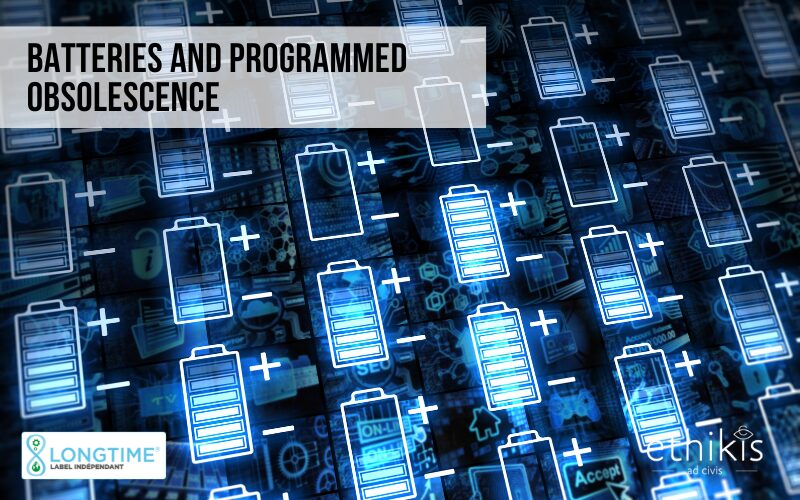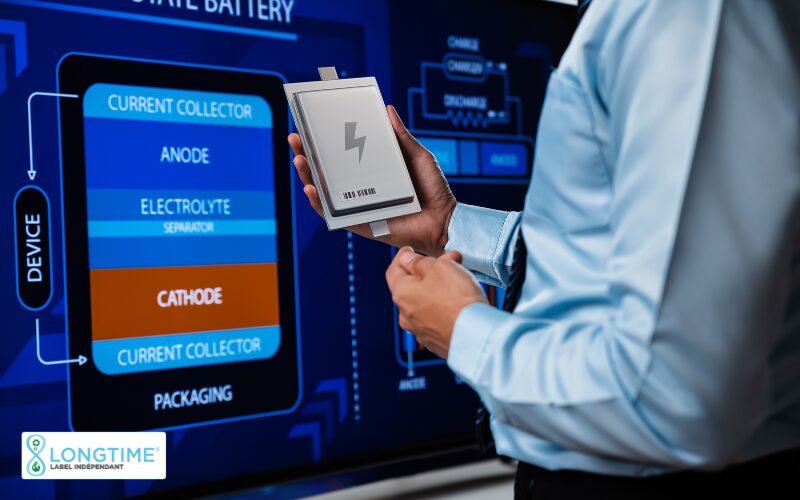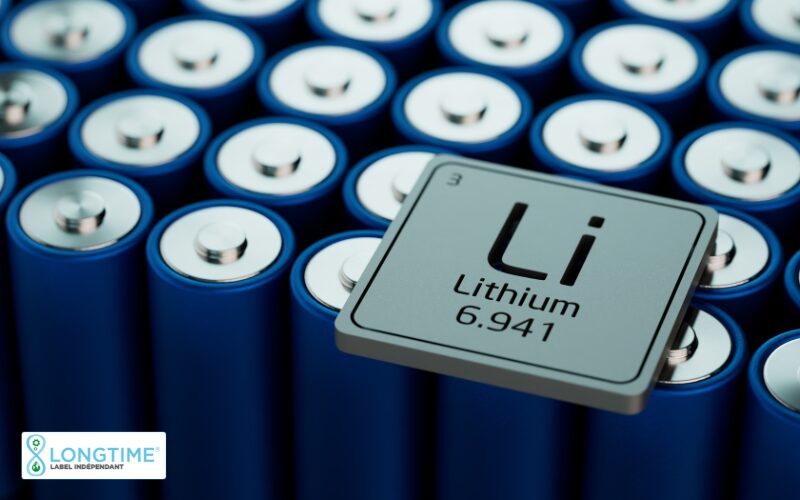
The role of batteries in programmed obsolescence
What is the role and impact of batteries on the lifespan of electrical appliances?
Lithium-ion batteries are becoming increasingly common in our equipment, but their limited lifespan and sometimes complex replacement can make them a major factor in premature obsolescence.
Too often impossible to dismantle or costly to replace, they raise major issues of reparability and sustainability. This article looks at the role of batteries in product durability, and how we can move away from the disposable model.
What is a battery?
A battery is a device that stores energy in chemical form and releases it in electrical form to power a device. It is made up of interconnected electrochemical cells, each comprising two electrodes and an electrolyte.
Essential in our electronic equipment, modern batteries must combine performance, durability and safety. Their sustainable design and proper end-of-life management are crucial to reducing their environmental impact and promoting a circular economy.
Main battery functions
Present in a multitude of everyday devices, batteries fulfill several essential functions. They don’t just power a device: their design, capacity and sturdiness are adapted to specific uses, whether it’s a simple remote control or an electric bike. Understanding their main functions enables us to measure their importance in the durability of our equipment.
Energy storage and distribution
The primary function of a battery is to store the energy produced during charging, and then release it in a controlled manner. This energy is used to operate various electronic components according to the user’s needs, without the need for a cable connection to the mains.
In a lithium-ion battery, this operation is based on the movement of lithium ions between the anode and cathode through the electrolyte. This mechanism enables high energy efficiency, but also requires precise management, provided by the BMS.
Power supply for portable devices
Whether for a smartphone, a drill or an electric bike, the battery enables cordless operation, independent of the electrical grid. This implies high energy density, optimized design (mass, weight, etc.), and mechanical and thermal integration designed for safety and durability.
Differences between technologies and applications
The technical requirements for a battery differ depending on whether it is intended for :
- A low-power device (e.g. remote control): where capacity and miniaturization are paramount.
- Hand-held power tools: where current intensity and robustness are critical.
- An electric vehicle: where thermal management, safety, modularity and robustness are essential.
Different battery types and compositions (lithium-ion, lithium-polymer, NiMH, etc.).
Lithium-ion (Li-ion) batteries dominate the market for electronic and portable electrical equipment, thanks to their excellent energy density, low weight and high efficiency. They have become the standard for smartphones, computers, bicycles, DIY tools and even electric vehicles.
Key technologies include :
- Li-ion: widely used in modern equipment.
- LiPo (lithium-polymer): a flexible version, popular for compact designs.
- NiMH (nickel-metal hydride): still present in some household equipment.
- Plomb-acide : réservée principalement à l’automobile.
The LONGTIME® standard only covers removable rechargeable Li-ion batteries for hand-held power tools, and excludes other types, such as those used in the automotive industry.

Chemical composition and operating principles
A Li-ion battery is based on a reversible electrochemical reaction between a graphite anode and a lithium oxide cathode, via a liquid or gel electrolyte and a microporous separator. This system enables lithium ions to be transferred during charge/discharge cycles, generating a current by charge transfer. It is therefore based on electrochemical principles, where reactions between the electrodes and the electrolyte generate a flow of lithium ions.
This technology is supported by an electronic management system – the BMS (Battery Management System) – which ensures safety, performance, battery life and data traceability.
Technical data (capacity, voltage, service life)
Three essential indicators define a battery’s performance:
- Capacity: expressed in mAh or Wh, this measures the amount of energy stored.
- Voltage: typically 3.6 to 3.7 V per cell for Li-ion.
- Service life: measured in complete cycles. A quality battery can achieve between 500 and 1,500 cycles. The maximum number of cycles depends on the size of the battery and its end use.
For example, in the LONGTIME® quality standards for hand-held power tools, a battery must retain 80% of its capacity after 1,300 cycles to qualify for certification. This performance is verified by endurance tests (type IEC 61960-3, EN 45552), reflecting a higher resistance than the market average.
Criteria that can influence battery life
A battery’s lifespan does not depend solely on its use by the user. Right from the design stage, several factors come into play: the quality of materials, the care taken in manufacturing, the complexity of electronic protection and the optimization of management algorithms. All these factors influence a battery’s ability to maintain its performance over time and avoid premature obsolescence.
The quality of materials
The quality of the materials used in a lithium-ion battery is a determining factor in its longevity. This applies to :
- Electrodes: high-purity graphite for the anode or a well-stabilized NMC (nickel-manganese-cobalt) cathode guarantee better cycle life over time.
- The electrolyte: its formulation has a direct impact on SEI layer formation, thermal stability and ionic conductivity.
- Separators: their mechanical strength and ability to block short-circuits are key to long-term safety.
Low-quality materials can accelerate the formation of internal defects, cause parasitic reactions, and even reduce effective capacity in the first few months of use.
Build quality and price
The final price of a battery rarely reflects the full complexity of its design. All too often, upstream economic trade-offs dictate technical choices that are detrimental to the battery’s longevity. This can manifest itself in various ways:
- Lower material costs: use of inferior electrodes, unstable electrolytes or cheap separators.
- Assembly optimized for production, not maintenance: components are glued, crimped or molded, making subsequent intervention impossible.
- Eliminate electronic or thermal protection, to save space or reduce costs.
- Lack of redundancy in BMS systems, making the device vulnerable in the event of a simple sensor failure.
While these strategies reduce the initial cost, they also increase the failure rate, rendering the battery irreparable or non-reusable at the first failure.
Battery management algorithms
The longevity of a battery also depends on its electronic management, provided by the BMS. This system balances the cells, regulates temperature, limits extreme voltages and monitors the state of health (SoH/SoC).
A BMS that is too basic can lead to premature wear and tear, or even block any attempt at replacement through software restrictions.
Battery wear and ageing factors
Over time, all batteries undergo progressive degradation, even when used in optimal conditions. This wear is the result of multiple mechanical, chemical and environmental factors. Understanding these mechanisms enables us to identify good usage practices and encourage more sustainable design, so as to really extend the life of our equipment.
Charging and discharging cycles
Each lithium-ion battery is designed to undergo a certain number of complete charge and discharge cycles, i.e. from 0% to 100% capacity and back. It has been found that most users perform partial cycles, but these add up to complete cycles.
Over time, these cycles generate :
- Mechanical wear of electrodes (fractures, loss of contact).
- Residue build-up on electrolyte/electrode interfaces (SEI – Solid Electrolyte Interphase).
- Increased internal resistance, reducing energy efficiency.
- A gradual reduction in useful capacity.
The LONGTIME® standard requires that power tool batteries retain at least 80% of their rated capacity after 1,300 complete cycles. This requirement exceeds market standards, and is verified by accelerated endurance tests using standardized protocols (IEC 61960-3, EN 45552). These cycles can be simulated in an accredited laboratory to guarantee realistic extrapolation of service life.
Impact of temperature
Temperature is a critical factor in the durability of lithium-ion batteries. Above 45°C or below -10°C, chemical aging accelerates, with the risk of swelling or thermal failure. Here are a few effects:
- Hot: parasitic reactions, degradation of stability, risk of runaway.
- Cold: drop in performance, increase in resistance, risk of rapid loading.
The LONGTIME® label imposes standardized thermal resistance tests to guarantee stability and safety of use, even under extreme conditions.
Controlling temperature preserves battery life and safety.
The influence of operating conditions
The way a battery is used on a daily basis has a major impact on its longevity. Poor usage, charging and maintenance practices can considerably accelerate the degradation process, and there are many of them in practice.
Among the most common harmful practices:
- Use uncertified or unsuitable chargers that do not offer correct voltage or current regulation.
- Constantly charging the battery up to 100%, which at high voltages accentuates oxidation of the cathode (many of us leave our smartphones on charge all night, for example!)
- Repeatedly discharging the battery to full capacity can lead to a critical voltage which can damage the graphite electrode.
- Leaving the battery unused for months can lead to irreversible deep discharge.
Manufacturers committed to sustainability must therefore integrate an intelligent management system (such as the BMS) that enables :
- Limit extreme voltage ranges.
- Regulate temperature during charging.
- Record health parameters (SoH, cycles, critical temperatures, etc.).
- And to guide the user with warning messages or safe charging modes.
As part of the LONGTIME® assessment, these functions must be accompanied by clear instructions for use, explaining best practices (avoiding prolonged loads, storage recommendations, etc.), and promoting responsible long-term use of the product.
In short, user behavior is an important lever for extending or reducing battery life – provided the product is designed to tolerate and control actual usage.
Chemical aging of components
Even when used optimally, a lithium-ion battery undergoes unavoidable chemical ageing, linked to slow reactions that gradually alter its internal components.
Effects include :
- Growth of the SEI layer, increasing resistance.
- Dissolution of cathode, loss of capacity.
- Gas formation, risk of swelling.
- Loss of active lithium, reducing payload.
Aging depends on the quality of materials, cell design and manufacturing processes.

Batteries and programmed obsolescence
Batteries have become a sore point in the debate on programmed obsolescence. Their failure, often premature, is at the heart of many controversies. Between real technical limitations and questionable design choices, the difficulty of replacing a battery can turn a still-functioning device into electronic waste. These practices are increasingly raising questions among consumers, repairers and legislators about the transparency, repairability and durability of electronic equipment.
Testimonials from repairers and experts
Repair professionals are usually the first to witness the limitations imposed by the design of certain batteries. Their testimonials reveal recurrent cases where battery replacement is technically possible, but discouraged by certain obstacles:
- Batteries welded or bonded to the internal structure,
- Complex battery access requiring proprietary tools,
- Software locks prevent integration of a battery that is functional but not original.
For the LONGTIME® team, such practices run counter to repairability criteria, which advocate that the end-user or an independent repairer should be able to work on the product under reasonable conditions of time, access, cost and safety.
Case studies
The evolution of smartphone design is a perfect illustration of how the battery can become a lever for functional obsolescence. In the 2000s, replacing a phone’s battery was simple, quick and accessible: a removable back shell, a battery that could be removed by hand, and that was it, remember? No tools or special technical skills were required.
Today, the situation has changed radically. Take an iPhone, for example: to change the battery, you have to :
- Remove the screen (fragile and sealed),
- Heat and remove the strong adhesives holding the battery in place,
- Use specific tools,
- Scrupulously follow a tutorial (such as those offered by iFixit, which gives devices a reparability rating).
Even with these resources, the cost of a replacement by Apple varies from €79 to over €119, depending on the model, excluding warranty. This cost discourages many users, especially as the battery is often not the only component to wear out.
According to a study carried out by Kantar for Recommerce (2023), a staggering 32% of French people change their smartphone because of a worn-out battery or one that no longer holds a charge. This statistic confirms the extent to which a non-replaceable battery can easily contribute to premature obsolescence, and an increase in electronic waste.
The difference between genuine technical failure and deliberate intent
It’s sometimes difficult to distinguish between natural wear and tear – inevitable over time – and a deliberate strategy of obsolescence. But there are a number of concrete cases, documented and publicized in the media, that can help remove any doubt.
One emblematic example concerns Apple, targeted by several actions by the HOP (Halte à l’Obsolescence Programmée) association. In 2017, Apple admitted to having voluntarily slowed down the performance of certain iPhone models (6, 6S, SE…) when their batteries were aging. The official aim was as follows: to avoid unexpected shutdowns. But the problem was that this measure was applied without transparency or user consent, and above all without offering a reasonably-priced replacement solution in the first instance.
HOP has lodged a complaint, denouncing a strategy of “disguised software bridging” to encourage early renewal. This affair, known as “Batterygate”, led to Apple being fined 25 million euros in France in 2020, and to legal action in the United States, where the firm agreed to pay up to 500 million dollars in compensation.

Economic and environmental challenges of battery-powered appliances
The importance of batteries in our electronic devices is not limited to their operation: their durability also influences major economic issues and has a considerable environmental impact. From the cost of replacement to the difficulty of recycling, batteries play a central role in extending or accelerating the life cycle of equipment. Better design and management of batteries is essential to reduce wastage of resources and limit our ecological footprint.
Cost of battery replacement
Replacing a worn-out battery, especially if difficult or costly, may result in premature disposal of the entire unit. This has direct economic consequences for consumers:
- High cost of replacement (often over €100, as seen with the iPhone),
- Lack of perceived profitability of a repair compared with the cost of a new appliance,
- Associated software obsolescence, leading to complete equipment replacement.
On a large scale, this represents a colossal loss in untapped use value, and a major economic waste. For companies or local authorities, these frequent replacements generate a total cost of ownership (TCO) far higher than that of a repairable, durable device.
Premature battery ageing also leads to rapid depreciation of the device, making it unattractive for resale or secondary use, and leading to the consumption of new products.
Ecological impact
Environmental impacts are just as critical:
- Extraction of critical raw materials (lithium, cobalt, nickel), often associated with major social and ecological impacts.
- CO₂ emissions linked to the production of new batteries and devices.
- Ever-increasing e-waste, with collection and recycling still insufficient (only 17.4% of the world’s e-waste was recycled in 2019, according to the Global E-waste Monitor).
The battery is a high-impact component in the Life Cycle Assessment (LCA) of devices. Extending its useful life could even halve the carbon emissions associated with a smartphone, for example, according to ADEME studies.
Recycling and the circular economy
At the end of its life, a lithium-ion battery is far from being a simple waste product: it contains high-value materials (lithium, cobalt, copper, nickel, graphite) whose recovery is strategic from both an ecological and an economic point of view. But for recycling to be possible and effective, the battery must be designed to be dismantled and sorted.
At present, effective recycling rates are still low. In France, according to ADEME, less than 50% of lithium-ion batteries are effectively recycled, and only certain materials are recovered at satisfactory rates (e.g. cobalt). Many cells, poorly designed or unable to be dismantled, end up being incinerated, with significant material losses.
Integrating batteries into a circular economy therefore involves :
- Modular design for easy disassembly, identification and separation of materials,
- The use of recyclable and identified materials (traceability requirement),
- The introduction of a battery passport to track usage history and second-life potential,
- Structured, accessible collection channels for both private and professional customers.
Another option is to recondition used batteries, in particular by replacing faulty cells, to give them a second life in less demanding applications. The LONGTIME® standard recognizes products that integrate these logics.
This also implies better organization of materials recovery, in particular through less energy-intensive transformation processes.
Solutions and prospects
Faced with the current limitations of batteries and growing environmental challenges, many solutions are emerging. Technological innovation plays a key role in extending battery life, improving reparability and reducing their ecological impact. New chemistries, more sustainable architectures, ambitious regulations and stronger consumer rights are paving the way for more responsible battery management in a circular economy under construction.
New battery technologies
To overcome the current limitations of lithium-ion batteries, new technologies and architectures are being developed. They aim to increase service life, improve safety, reduce dependence on critical materials and facilitate repairability or recycling.
Among the most promising are :
- Solid-state batteries: more stable, they eliminate the need for flammable liquid electrolyte, reduce the risk of short-circuits and could offer higher energy density, while limiting chemical ageing.
- Sodium-ion batteries: using sodium instead of lithium, they are less efficient to date, but more sustainable in terms of resources (sodium being abundant and inexpensive), with great potential for stationary applications or medium-range devices.
- LFP (Lithium-Fer-Phosphate) batteries: increasingly used in electric vehicles, they offer superior longevity and thermal stability, although their energy density is somewhat lower.
Other alternatives are emerging, such as supercapacitors, which offer high power density but limited autonomy compared with Li-ion batteries.
Research into battery life
The durability of a battery depends as much on its conditions of use as on its materials. A great deal of research has gone into prolonging battery performance through :
- BMS-integrated predictive models to anticipate capacity losses,
- Adaptive charging algorithms, adjusted to SoH and temperature,
- Early detection of failures via sensors and AI,
- Improving chemical interfaces to stabilize internal reactions.
These innovations make batteries more resistant, and potentially more repairable and reconditionable. But their impact depends on real industrial transfer and clearly established durability standards.
Consumer rights and regulations
Faced with environmental challenges and the growing need for sustainable products, new regulations have been introduced to govern the manufacture, use and end-of-life of batteries. They aim to increase transparency, guarantee better reparability and protect consumer rights. By imposing standards of performance, information and responsibility, these measures mark a key step towards a more demanding circular economy.
Product life cycle legislation
European regulations are evolving to integrate batteries into a logic of legal sustainability, with requirements that affect manufacturers, distributors and consumers alike.
Regulation (EU) 2023/1542, adopted in July 2023, introduces for the first time sustainability, safety, traceability and reparability obligations specific to batteries, whether portable, industrial or for electric vehicles. In particular, it provides for:
- Minimum performance criteria (capacity, service life, thermal resistance),
- A digital battery passport including state of health (SoH), number of cycles, and critical events,
- The obligation to provide information on dismantling, replacement and recycling,
- Minimum availability of spare parts.
Eventually, harmonization with international standards could reinforce the impact of these measures on global markets.
These advances complement eco-design directives and national laws in favor of displaying reparability (such as France’s reparability index), which oblige brands to make greater transparency and design efforts.
Manufacturers’ obligations
Manufacturers must now move from a focus on immediate performance to sustainable design throughout the entire life cycle. This change is driven by European legislation and labels such as LONGTIME®.
The main obligations include :
- Effective reparability (easy disassembly without destroying the product)
- Extended parts availability (up to ten years), depending on the product
- Publication of technical information (dismantling, safety, carbon footprint)
- Traceability via battery passport
- Compliance with Extended Producer Responsibility (EPR).
These requirements also ensure that products comply with the new European standards, while reinforcing consumers’ right to repair.
Repair and replacement options
Battery reparability is a major lever for sustainability, but is often hampered by industrial practices such as glued, welded or software-locked batteries. These obstacles make battery replacement complex, costly and even impossible outside the official network.
For a repair to be truly feasible, you must :
- Easy access without proprietary tools or destructive adhesives,
- Parts available individually or as complete kits,
- Software compatibility without blocking after replacement,
- Accessible technical information to guide repairers,
- A reasonable part price, ≤ 30% of the new price.
These criteria are at the heart of the LONGTIME® label, which imposes high standards to ensure that maintenance is possible and transparent.
Promoting reparability means extending the life of products, reducing costs and waste, and supporting more responsible consumption.
The legal warranty should also cover work on the battery, as long as it complies with the manufacturer’s technical standards.
Corded or hand-held: how to make the right choice for a durable product?
The choice between a corded and an electrically-powered product is not just a question of comfort or modernity. It has a direct influence on the equipment’s durability, overall cost and environmental impact. Taking the time to analyze your real needs will enable you to opt for an adapted, reliable and more responsible solution.
Actual use and frequency of use
First and foremost, it’s essential to assess the frequency of use and the real need for mobility. For regular use requiring frequent travel (e.g.: building sites, outdoor work, recurring jobs), hand-held power tools offer appreciable freedom of movement. On the other hand, for occasional needs, such as drilling a few holes or fixing shelves once or twice a year, a corded model is often more suitable: it remains immediately available without the need for recharging, and avoids premature battery wear through deep discharge.
Need for power and endurance
When work requires high, sustained power – intensive sanding of large surfaces, sawing of thick materials, perforation of concrete walls – wired sanding is preferable. Unlike battery-powered machines, which can lose performance over time due to energy and thermal limitations, corded machines deliver constant, reliable power over extended periods, with no risk of efficiency loss.
Environmental impact and sustainability
Batteries used in hand-held power tools consume large quantities of natural resources (lithium, cobalt, nickel) and generate a significant carbon footprint during manufacture. A corded, battery-free device limits this environmental impact throughout its lifecycle.
For a more durable choice, if you need to use an electric tool, it’s best to opt for a device with a removable battery that can be shared between several products in the same range.
Total cost of ownership and reparability
The initial purchase price should not be the only criterion for decision-making. You also need to consider the total cost of ownership (TCO), including maintenance, battery replacement, repairability and spare parts availability.
A wired device is often cheaper to buy, less costly to maintain and easier to repair over the long term.
Please note: more and more brands are offering hand-held power tools without batteries, at prices similar to those of corded models. In reality, you have to add the cost of the battery and charger. However, this approach also favors greater sustainability: it enables the same battery to be shared between several compatible appliances, thus limiting the production of new batteries.
To ensure a lasting purchase, we recommend that you give priority to :
- Products with a high reparability index,
- Those certified by an independent label such as LONGTIME®,
Those offering good availability of parts and batteries over time.
For a better comparison, here’s a summary of the advantages and disadvantages of the two types of device:
|
Criteria |
Wired product |
Electroportable product |
|
Initial purchase price |
Weaker |
Higher (especially with purchase of separate battery) |
|
Total cost of ownership (TCO) |
Low (limited maintenance) |
Higher (battery maintenance, replacement) |
|
Repairability |
Easy (fewer sensitive components) |
More complex (battery, BMS, electronics) |
|
Parts availability |
Long for quality products |
Varies by brand |
|
MobilitY |
Limited to the electrical network |
Freedom of movement |
|
Intrinsic durability |
Sturdier for heavy-duty use |
Depends on battery quality |
|
Environmental impact |
Weaker |
Higher (battery production and recycling) |
|
Possible pooling |
Non applicable |
Yes, if battery common to several products |
Tips for testing and maintaining your battery
The life of a battery depends as much on its quality as on its day-to-day maintenance. To avoid premature wear and tear, it’s essential to learn how to monitor its health and adopt a few simple maintenance gestures. Easy-to-access tools and good practices can considerably extend a battery’s performance and limit its environmental impact.
Diagnostic methods
To assess whether a battery is starting to weaken, several simple methods can be used to monitor its state of health (SoH) and anticipate a failure:
- Android: some apps measure capacity, temperature, charging speed and number of cycles.
- iOS: via Settings > Battery > Battery status.
- Mac: Apps display SoH and cycle evolution.
- Windows: command powercfg /batteryreport to generate a wear report.
- Actual performance: Reduced autonomy, even after a full charge, is often a sign of ageing.
- Full-load test: Performing a full cycle (0 to 100%) allows you to observe whether the actual capacity has been maintained.
- Internal resistance measurement: Reserved for technicians, a value >150 mΩ signals advanced wear.
These diagnoses make it easier to take informed decisions: adapting use, monitoring or considering replacement.
Signs of aging
- Significantly reduced autonomy despite full charge cycles.
- Unusual heating under load or during use.
- Battery swells, distorts the case or makes it unstable.
- Sudden extinctions, even with a high load percentage displayed.
Maintenance tips
- Avoid systematically charging to 100%: aiming for a charge of between 20% and 80% will extend service life.
- Do not leave the unit permanently plugged in.
- Store at half-load if not used for several weeks.
- Avoid frequent rapid charging if not necessary.
- Use a certified charger suitable for the device.
Conclusion
Lithium-ion batteries are at the heart of our daily technological lives. But their central role hides a problematic reality: their rapid wear and tear, their sometimes complex replaceability, and sometimes their software lock-in make them major vectors of functional obsolescence. There’s a fine line between real technical limitations and questionable industrial choices.
Future prospects
In the face of these facts, solutions exist: modular batteries, more stable technologies, standards favoring reparability, software innovations. Regulatory developments (notably at European level) and standards such as LONGTIME® are already paving the way for more sustainable, reusable and recyclable products.
An economic model based on sustainability becomes essential, valuing products that are repairable, upgradeable and compatible with long-term thinking.
A call to awareness and responsibility
Manufacturers have a responsibility to design to last. Consumers have a responsibility to choose repairable products, to demand transparency, and to adopt practices that preserve the longevity of equipment. Together, we can break with the logic of disposability.
It’s an approach rooted in the principles of sustainable development, aimed at preserving natural resources and limiting waste.
The LONGTIME® label provides a demanding framework for their design, maintenance and reuse.
